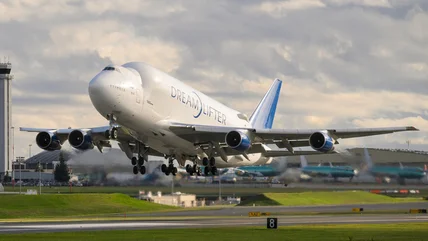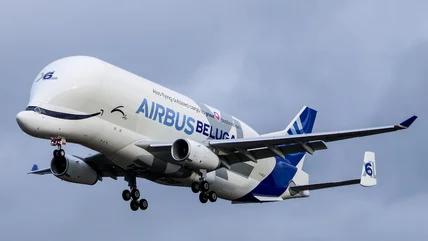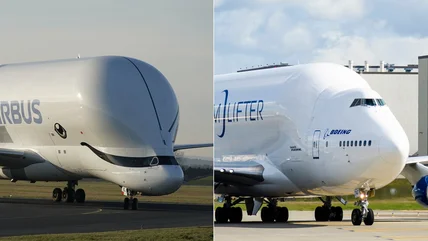The world of aviation has many giants, but none stand out quite like the Boeing Dreamlifter and the Airbus BelugaXL. These two massive cargo planes play a critical role in the aerospace industry, transporting large aircraft parts and oversized cargo that no other planes can carry. Both have unique features and serve a specific purpose, but what exactly sets them apart? This article dives deep into the differences between the Boeing Dreamlifter and the Airbus BelugaXL.
Boeing Dreamlifter: The Giant of the Skies

The Boeing Dreamlifter, officially known as the Boeing 747-400 Large Cargo Freighter (LCF), is a modified version of the Boeing 747-400. Developed by Boeing to transport parts of its aircraft, particularly the 787 Dreamliner, the Dreamlifter has been in service since 2007. This massive aircraft is primarily used to transport large parts like fuselage sections, wings, and other components from suppliers worldwide to Boeing’s assembly plants.
One of the most striking features of the Dreamlifter is its enormous size. The aircraft is 235 feet long, with a wingspan of 211 feet. The Dreamlifter’s most notable modification is its enlarged fuselage, which is designed to carry oversized cargo. It has a unique swing-tail design, allowing the rear of the plane to open up and provide access to its cavernous cargo hold. This feature enables the loading and unloading of massive items that wouldn’t fit through a standard cargo door.
The Dreamlifter’s capacity is impressive. It can hold up to 65,000 cubic feet of cargo, making it one of the largest cargo aircraft in the world. Despite its size, the Dreamlifter can reach a cruising speed of around 474 knots (about 545 mph), making it a relatively fast cargo plane. However, its range is somewhat limited compared to other cargo planes, with a maximum range of about 4,200 nautical miles when fully loaded.
Airbus BelugaXL: The New Contender

The Airbus BelugaXL is the latest addition to Airbus’s fleet of cargo aircraft. Introduced in 2019, the BelugaXL is a successor to the original Airbus Beluga, which has been in service since 1995. The BelugaXL was developed to meet Airbus’s increasing demand for transporting larger aircraft parts, such as wings, fuselage sections, and other components, between its various production sites across Europe.
The BelugaXL is based on the Airbus A330-200 freighter, but it features an enlarged fuselage that gives it its distinctive “whale” shape. The aircraft is 207 feet long, with a wingspan of 197 feet. Unlike the Dreamlifter, the BelugaXL does not have a swing-tail design. Instead, it has a unique cargo door located above the cockpit, which allows for easy loading and unloading of oversized cargo. This design minimizes turnaround time and improves efficiency, especially when handling large parts like wings or fuselage sections.
The BelugaXL can carry up to 68,000 cubic feet of cargo, slightly more than the Dreamlifter. Its maximum payload capacity is about 51 tonnes (112,000 pounds), and it can fly at a cruising speed of 459 knots (around 528 mph). The BelugaXL also has a longer range than the Dreamlifter, with a maximum range of 4,000 nautical miles when fully loaded.
Design Differences: Shape, Size, and Structure
The most noticeable difference between the Boeing Dreamlifter and the Airbus BelugaXL is their design. The Dreamlifter’s design is based on the Boeing 747-400, giving it a more traditional look with its extended fuselage and large wingspan. The aircraft’s swing-tail design is another unique feature, allowing for easy access to its spacious cargo hold. This design makes the Dreamlifter ideal for transporting long and bulky items, such as aircraft wings and fuselage sections.
On the other hand, the Airbus BelugaXL has a more unconventional design, with its bulbous fuselage and whale-like shape. The BelugaXL’s design is based on the Airbus A330-200, but its enlarged fuselage gives it a distinctive appearance. The cargo door above the cockpit is another unique feature, allowing for quick and easy loading and unloading of oversized cargo. This design is particularly useful for transporting large aircraft parts, as it minimizes turnaround time and improves efficiency.
While both aircraft are designed to carry oversized cargo, the BelugaXL’s design allows it to carry slightly more cargo than the Dreamlifter. The BelugaXL’s maximum cargo capacity is 68,000 cubic feet, compared to the Dreamlifter’s 65,000 cubic feet. This difference may seem small, but it can make a significant impact when transporting large and heavy items.
Performance Comparison: Speed, Range, and Payload
When comparing the performance of the Boeing Dreamlifter and the Airbus BelugaXL, there are a few key differences to consider. Both aircraft are capable of carrying large and heavy cargo, but they have different strengths and weaknesses regarding speed, range, and payload capacity.
The Dreamlifter is slightly faster than the BelugaXL, with a cruising speed of 474 knots (about 545 mph) compared to the BelugaXL’s 459 knots (around 528 mph). However, the BelugaXL has a longer range than the Dreamlifter, with a maximum range of 4,000 nautical miles compared to the Dreamlifter’s 4,200 nautical miles. This means that the BelugaXL can fly longer distances without refueling, which can be an advantage when transporting cargo over long distances.
The BelugaXL also has a higher payload capacity than the Dreamlifter, with a maximum payload of 51 tonnes (112,000 pounds) compared to the Dreamlifter’s 42 tonnes (92,500 pounds). This higher payload capacity allows the BelugaXL to carry heavier cargo, which can be a significant advantage in certain situations.
Operational Roles: Purpose and Use
Both the Boeing Dreamlifter and the Airbus BelugaXL play a critical role in the aerospace industry, but they serve slightly different purposes. The Dreamlifter is primarily used by Boeing to transport parts of its aircraft, particularly the 787 Dreamliner, from suppliers worldwide to its assembly plants. The aircraft’s large cargo capacity and unique swing-tail design make it ideal for transporting long and bulky items like fuselage sections, wings, and other components.
On the other hand, the BelugaXL is primarily used by Airbus to transport large aircraft parts between its various production sites across Europe. The aircraft’s enlarged fuselage and unique cargo door design allow for quick and easy loading and unloading of oversized cargo, making it particularly useful for transporting large items like wings and fuselage sections. The BelugaXL’s higher payload capacity and longer range also make it a versatile choice for transporting heavy cargo over long distances.
Technological Advancements: Innovation and Efficiency
Both the Boeing Dreamlifter and the Airbus BelugaXL feature several technological advancements that make them unique in the world of cargo aviation. The Dreamlifter’s swing-tail design is a prime example of this, allowing for easy access to its spacious cargo hold and enabling the loading and unloading of large and bulky items. This design innovation has made the Dreamlifter a valuable asset for Boeing, particularly in transporting large aircraft parts.
The BelugaXL, on the other hand, features a more innovative design, with its enlarged fuselage and unique cargo door above the cockpit. This design minimizes turnaround time and improves efficiency, making the BelugaXL a more versatile choice for transporting large and heavy cargo. The aircraft’s advanced avionics and fuel-efficient engines also contribute to its overall efficiency, allowing it to fly longer distances without refueling.
Market Impact: Competition and Demand
The Boeing Dreamlifter and the Airbus BelugaXL are not just marvels of engineering; they also represent two different approaches to meeting the demand for oversized cargo transport in the aerospace industry. Boeing and Airbus, as two of the biggest aircraft manufacturers in the world, have unique requirements for transporting large aircraft components, and both companies have developed their specialized cargo planes to meet these needs.
The Dreamlifter has been in service since 2007 and has been a critical part of Boeing’s supply chain, particularly for the 787 Dreamliner. The aircraft’s large cargo capacity and unique design have made it a valuable asset for Boeing, allowing the company to transport large and bulky items quickly and efficiently.
The BelugaXL, meanwhile, is a more recent addition to the market, having been introduced in 2019. Its innovative design and higher payload capacity have made it a popular choice for Airbus, allowing the company to transport large aircraft parts more efficiently between its various production sites. The BelugaXL’s unique design has also given Airbus a competitive edge in the market for oversized cargo transport, as it can carry more cargo and fly longer distances than the Dreamlifter.
